CHEVROLET KODIAK 2007 Owners Manual
Manufacturer: CHEVROLET, Model Year: 2007, Model line: KODIAK, Model: CHEVROLET KODIAK 2007Pages: 430, PDF Size: 6.06 MB
Page 281 of 430
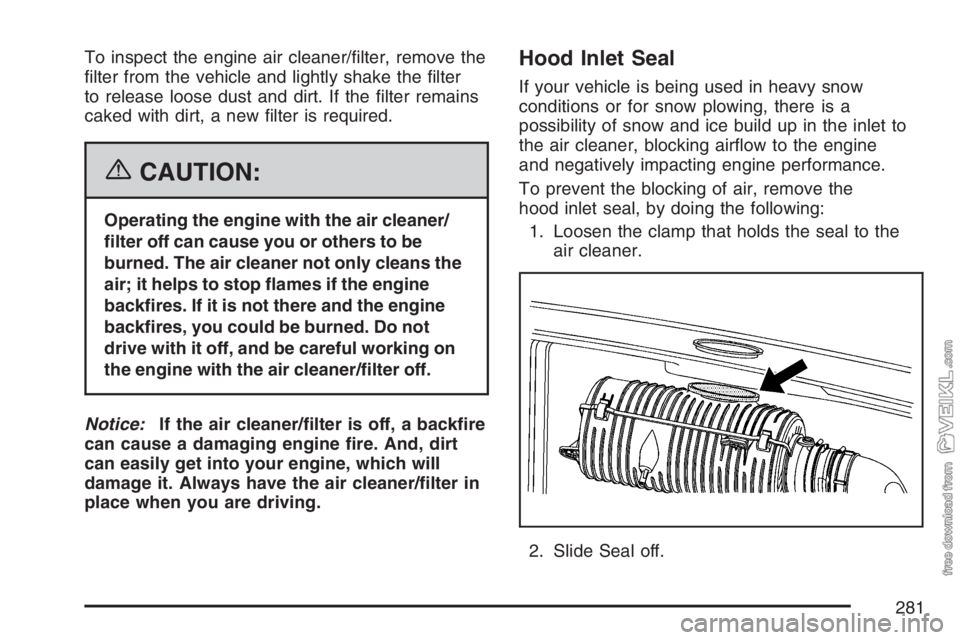
To inspect the engine air cleaner/filter, remove the
filter from the vehicle and lightly shake the filter
to release loose dust and dirt. If the filter remains
caked with dirt, a new filter is required.
{CAUTION:
Operating the engine with the air cleaner/
�lter off can cause you or others to be
burned. The air cleaner not only cleans the
air; it helps to stop �ames if the engine
back�res. If it is not there and the engine
back�res, you could be burned. Do not
drive with it off, and be careful working on
the engine with the air cleaner/�lter off.
Notice:If the air cleaner/�lter is off, a back�re
can cause a damaging engine �re. And, dirt
can easily get into your engine, which will
damage it. Always have the air cleaner/�lter in
place when you are driving.
Hood Inlet Seal
If your vehicle is being used in heavy snow
conditions or for snow plowing, there is a
possibility of snow and ice build up in the inlet to
the air cleaner, blocking airflow to the engine
and negatively impacting engine performance.
To prevent the blocking of air, remove the
hood inlet seal, by doing the following:
1. Loosen the clamp that holds the seal to the
air cleaner.
2. Slide Seal off.
281
Page 282 of 430
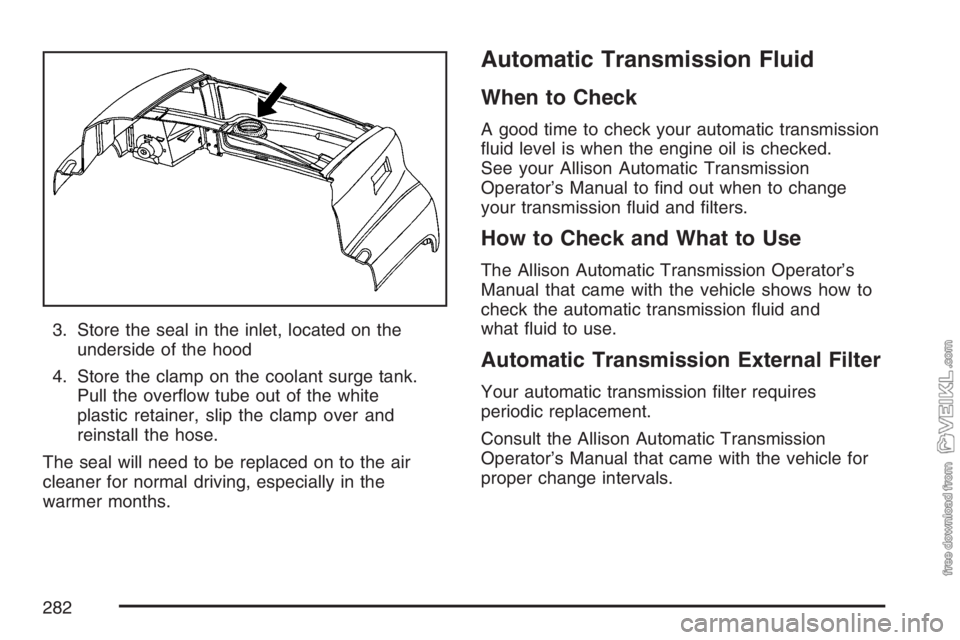
3. Store the seal in the inlet, located on the
underside of the hood
4. Store the clamp on the coolant surge tank.
Pull the overflow tube out of the white
plastic retainer, slip the clamp over and
reinstall the hose.
The seal will need to be replaced on to the air
cleaner for normal driving, especially in the
warmer months.
Automatic Transmission Fluid
When to Check
A good time to check your automatic transmission
fluid level is when the engine oil is checked.
See your Allison Automatic Transmission
Operator’s Manual to find out when to change
your transmission fluid and filters.
How to Check and What to Use
The Allison Automatic Transmission Operator’s
Manual that came with the vehicle shows how to
check the automatic transmission fluid and
what fluid to use.
Automatic Transmission External Filter
Your automatic transmission filter requires
periodic replacement.
Consult the Allison Automatic Transmission
Operator’s Manual that came with the vehicle for
proper change intervals.
282
Page 283 of 430
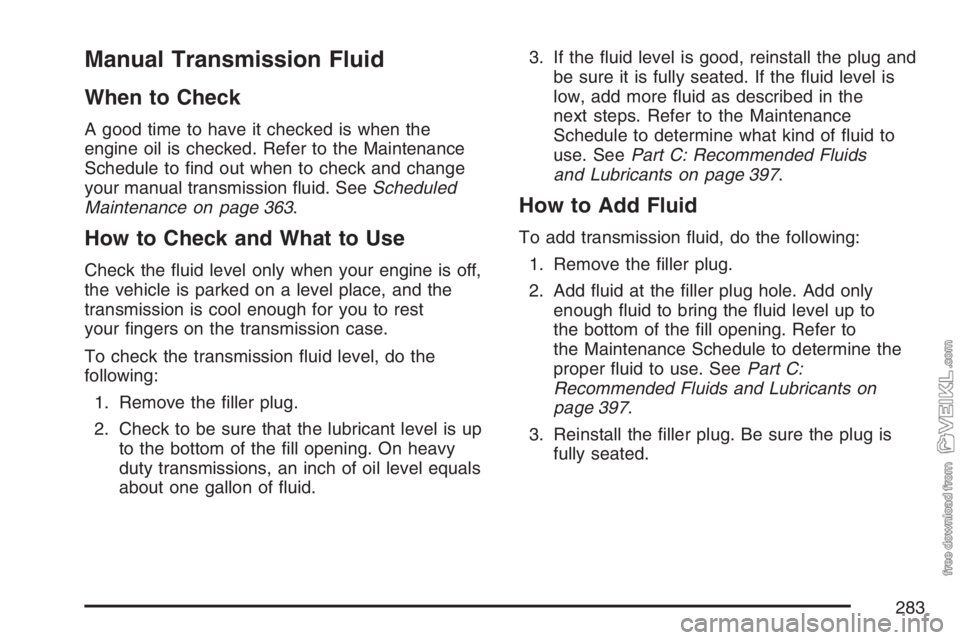
Manual Transmission Fluid
When to Check
A good time to have it checked is when the
engine oil is checked. Refer to the Maintenance
Schedule to find out when to check and change
your manual transmission fluid. SeeScheduled
Maintenance on page 363.
How to Check and What to Use
Check the fluid level only when your engine is off,
the vehicle is parked on a level place, and the
transmission is cool enough for you to rest
your fingers on the transmission case.
To check the transmission fluid level, do the
following:
1. Remove the filler plug.
2. Check to be sure that the lubricant level is up
to the bottom of the fill opening. On heavy
duty transmissions, an inch of oil level equals
about one gallon of fluid.3. If the fluid level is good, reinstall the plug and
be sure it is fully seated. If the fluid level is
low, add more fluid as described in the
next steps. Refer to the Maintenance
Schedule to determine what kind of fluid to
use. SeePart C: Recommended Fluids
and Lubricants on page 397.
How to Add Fluid
To add transmission fluid, do the following:
1. Remove the filler plug.
2. Add fluid at the filler plug hole. Add only
enough fluid to bring the fluid level up to
the bottom of the fill opening. Refer to
the Maintenance Schedule to determine the
proper fluid to use. SeePart C:
Recommended Fluids and Lubricants on
page 397.
3. Reinstall the filler plug. Be sure the plug is
fully seated.
283
Page 284 of 430
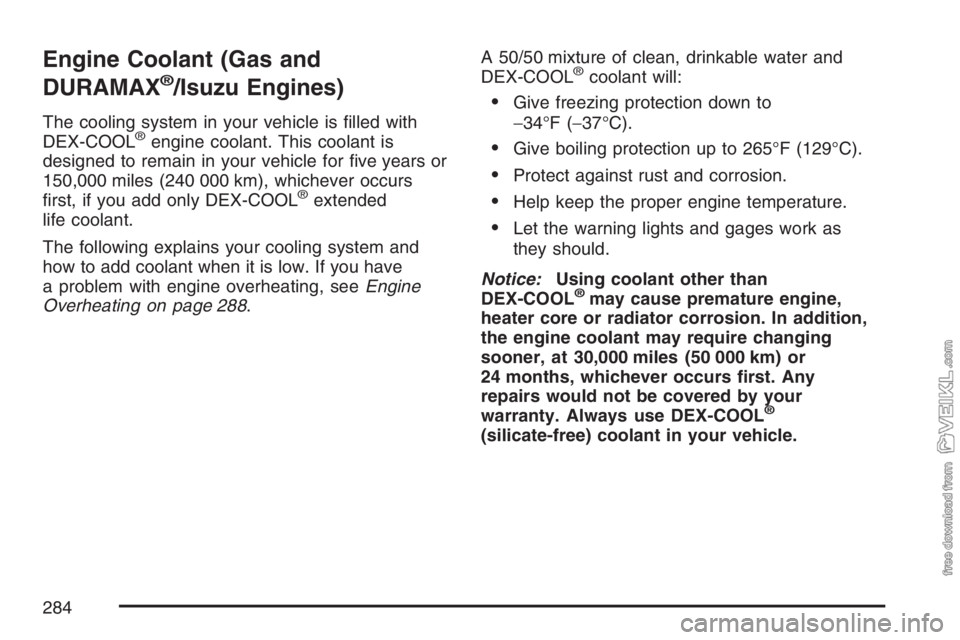
Engine Coolant (Gas and
DURAMAX
®/Isuzu Engines)
The cooling system in your vehicle is filled with
DEX-COOL®engine coolant. This coolant is
designed to remain in your vehicle for five years or
150,000 miles (240 000 km), whichever occurs
first, if you add only DEX-COOL
®extended
life coolant.
The following explains your cooling system and
how to add coolant when it is low. If you have
a problem with engine overheating, seeEngine
Overheating on page 288.A 50/50 mixture of clean, drinkable water and
DEX-COOL
®coolant will:
•Give freezing protection down to
−34°F (−37°C).
•Give boiling protection up to 265°F (129°C).
•Protect against rust and corrosion.
•Help keep the proper engine temperature.
•Let the warning lights and gages work as
they should.
Notice:Using coolant other than
DEX-COOL
®may cause premature engine,
heater core or radiator corrosion. In addition,
the engine coolant may require changing
sooner, at 30,000 miles (50 000 km) or
24 months, whichever occurs �rst. Any
repairs would not be covered by your
warranty. Always use DEX-COOL
®
(silicate-free) coolant in your vehicle.
284
Page 285 of 430
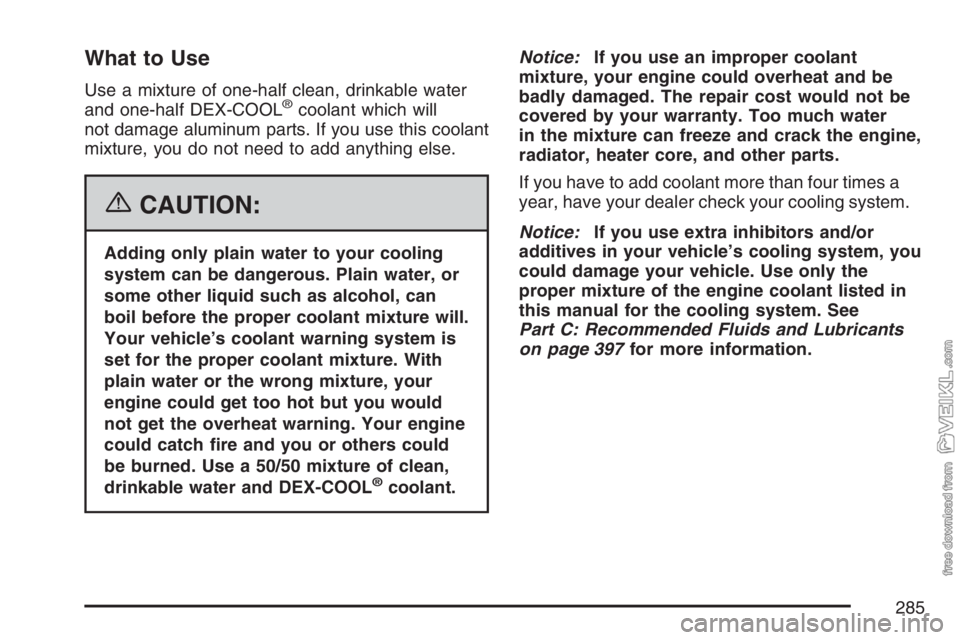
What to Use
Use a mixture of one-half clean, drinkable water
and one-half DEX-COOL®coolant which will
not damage aluminum parts. If you use this coolant
mixture, you do not need to add anything else.
{CAUTION:
Adding only plain water to your cooling
system can be dangerous. Plain water, or
some other liquid such as alcohol, can
boil before the proper coolant mixture will.
Your vehicle’s coolant warning system is
set for the proper coolant mixture. With
plain water or the wrong mixture, your
engine could get too hot but you would
not get the overheat warning. Your engine
could catch �re and you or others could
be burned. Use a 50/50 mixture of clean,
drinkable water and DEX-COOL
®coolant.Notice:If you use an improper coolant
mixture, your engine could overheat and be
badly damaged. The repair cost would not be
covered by your warranty. Too much water
in the mixture can freeze and crack the engine,
radiator, heater core, and other parts.
If you have to add coolant more than four times a
year, have your dealer check your cooling system.
Notice:If you use extra inhibitors and/or
additives in your vehicle’s cooling system, you
could damage your vehicle. Use only the
proper mixture of the engine coolant listed in
this manual for the cooling system. See
Part C: Recommended Fluids and Lubricants
on page 397for more information.
285
Page 286 of 430
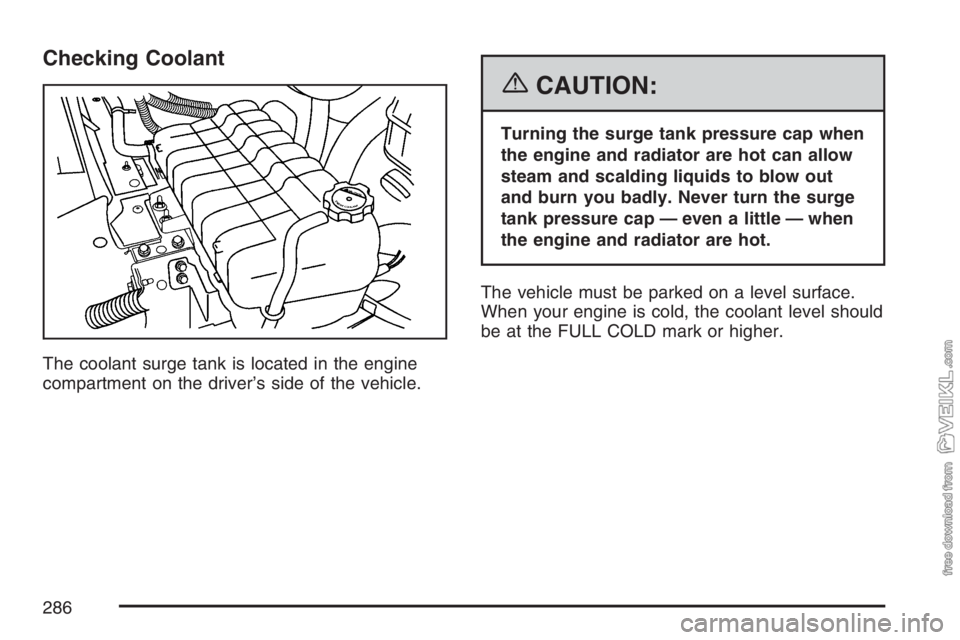
Checking Coolant
The coolant surge tank is located in the engine
compartment on the driver’s side of the vehicle.
{CAUTION:
Turning the surge tank pressure cap when
the engine and radiator are hot can allow
steam and scalding liquids to blow out
and burn you badly. Never turn the surge
tank pressure cap — even a little — when
the engine and radiator are hot.
The vehicle must be parked on a level surface.
When your engine is cold, the coolant level should
be at the FULL COLD mark or higher.
286
Page 287 of 430
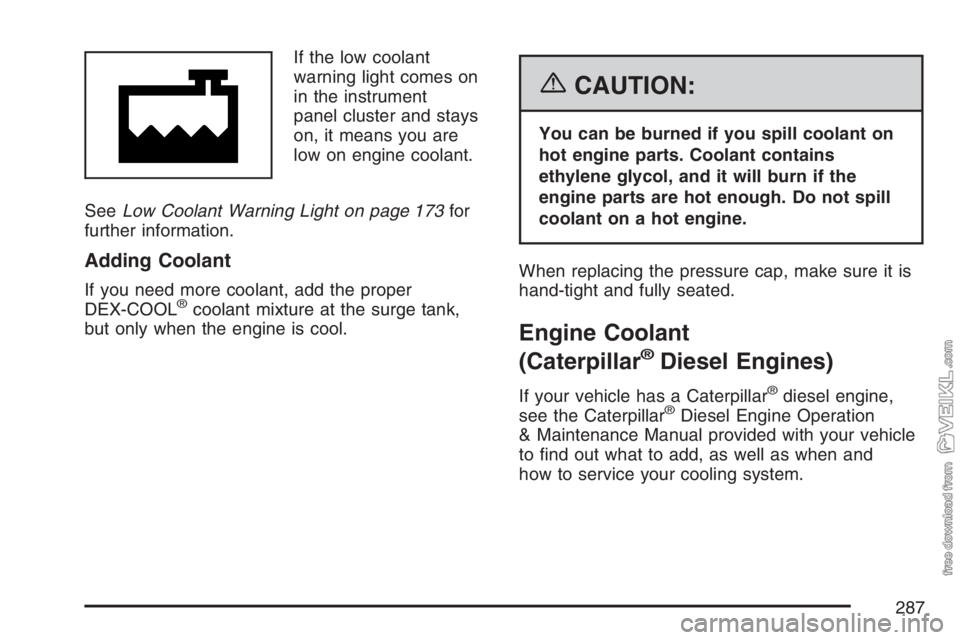
If the low coolant
warning light comes on
in the instrument
panel cluster and stays
on, it means you are
low on engine coolant.
SeeLow Coolant Warning Light on page 173for
further information.
Adding Coolant
If you need more coolant, add the proper
DEX-COOL®coolant mixture at the surge tank,
but only when the engine is cool.
{CAUTION:
You can be burned if you spill coolant on
hot engine parts. Coolant contains
ethylene glycol, and it will burn if the
engine parts are hot enough. Do not spill
coolant on a hot engine.
When replacing the pressure cap, make sure it is
hand-tight and fully seated.
Engine Coolant
(Caterpillar
®Diesel Engines)
If your vehicle has a Caterpillar®diesel engine,
see the Caterpillar®Diesel Engine Operation
& Maintenance Manual provided with your vehicle
to find out what to add, as well as when and
how to service your cooling system.
287
Page 288 of 430
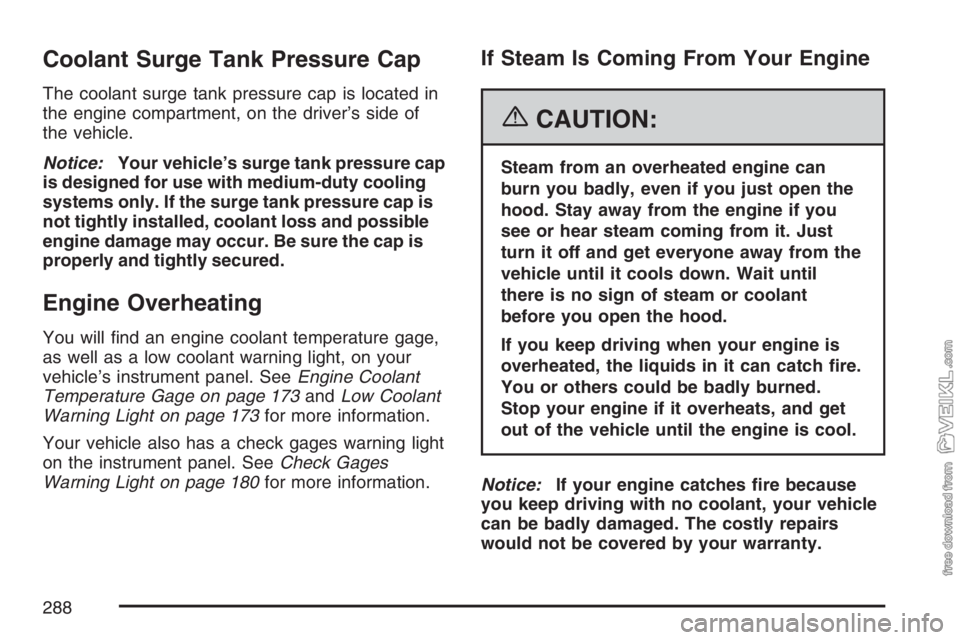
Coolant Surge Tank Pressure Cap
The coolant surge tank pressure cap is located in
the engine compartment, on the driver’s side of
the vehicle.
Notice:Your vehicle’s surge tank pressure cap
is designed for use with medium-duty cooling
systems only. If the surge tank pressure cap is
not tightly installed, coolant loss and possible
engine damage may occur. Be sure the cap is
properly and tightly secured.
Engine Overheating
You will find an engine coolant temperature gage,
as well as a low coolant warning light, on your
vehicle’s instrument panel. SeeEngine Coolant
Temperature Gage on page 173andLow Coolant
Warning Light on page 173for more information.
Your vehicle also has a check gages warning light
on the instrument panel. SeeCheck Gages
Warning Light on page 180for more information.
If Steam Is Coming From Your Engine
{CAUTION:
Steam from an overheated engine can
burn you badly, even if you just open the
hood. Stay away from the engine if you
see or hear steam coming from it. Just
turn it off and get everyone away from the
vehicle until it cools down. Wait until
there is no sign of steam or coolant
before you open the hood.
If you keep driving when your engine is
overheated, the liquids in it can catch �re.
You or others could be badly burned.
Stop your engine if it overheats, and get
out of the vehicle until the engine is cool.
Notice:If your engine catches �re because
you keep driving with no coolant, your vehicle
can be badly damaged. The costly repairs
would not be covered by your warranty.
288
Page 289 of 430
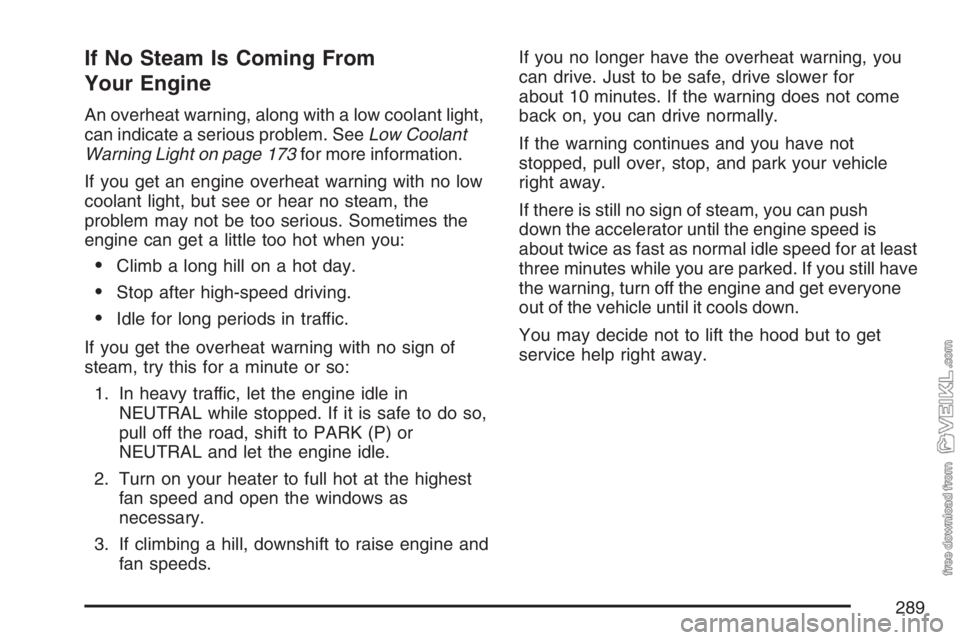
If No Steam Is Coming From
Your Engine
An overheat warning, along with a low coolant light,
can indicate a serious problem. SeeLow Coolant
Warning Light on page 173for more information.
If you get an engine overheat warning with no low
coolant light, but see or hear no steam, the
problem may not be too serious. Sometimes the
engine can get a little too hot when you:
•Climb a long hill on a hot day.
•Stop after high-speed driving.
•Idle for long periods in traffic.
If you get the overheat warning with no sign of
steam, try this for a minute or so:
1. In heavy traffic, let the engine idle in
NEUTRAL while stopped. If it is safe to do so,
pull off the road, shift to PARK (P) or
NEUTRAL and let the engine idle.
2. Turn on your heater to full hot at the highest
fan speed and open the windows as
necessary.
3. If climbing a hill, downshift to raise engine and
fan speeds.If you no longer have the overheat warning, you
can drive. Just to be safe, drive slower for
about 10 minutes. If the warning does not come
back on, you can drive normally.
If the warning continues and you have not
stopped, pull over, stop, and park your vehicle
right away.
If there is still no sign of steam, you can push
down the accelerator until the engine speed is
about twice as fast as normal idle speed for at least
three minutes while you are parked. If you still have
the warning, turn off the engine and get everyone
out of the vehicle until it cools down.
You may decide not to lift the hood but to get
service help right away.
289
Page 290 of 430
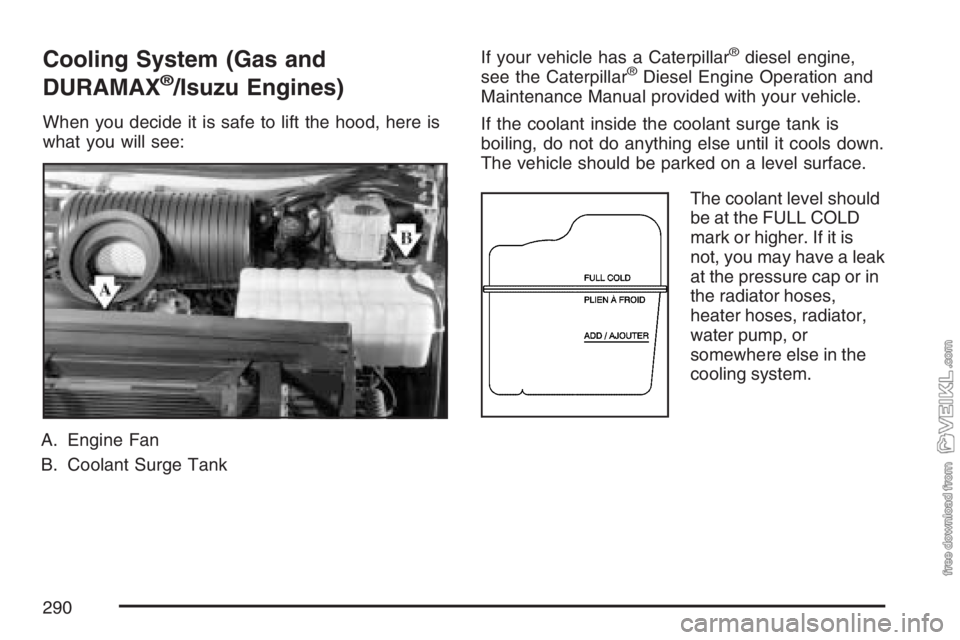
Cooling System (Gas and
DURAMAX
®/Isuzu Engines)
When you decide it is safe to lift the hood, here is
what you will see:
A. Engine Fan
B. Coolant Surge TankIf your vehicle has a Caterpillar
®diesel engine,
see the Caterpillar®Diesel Engine Operation and
Maintenance Manual provided with your vehicle.
If the coolant inside the coolant surge tank is
boiling, do not do anything else until it cools down.
The vehicle should be parked on a level surface.
The coolant level should
be at the FULL COLD
mark or higher. If it is
not, you may have a leak
at the pressure cap or in
the radiator hoses,
heater hoses, radiator,
water pump, or
somewhere else in the
cooling system.
290